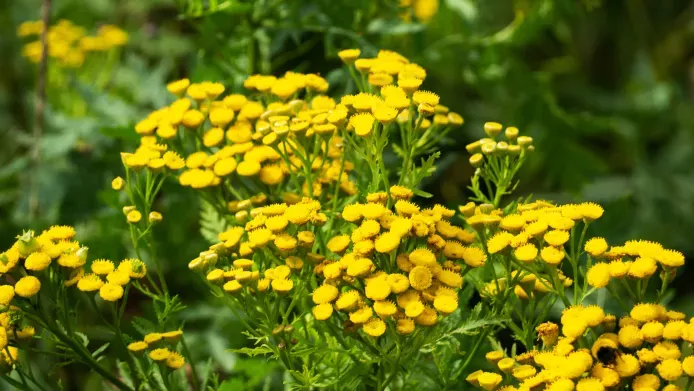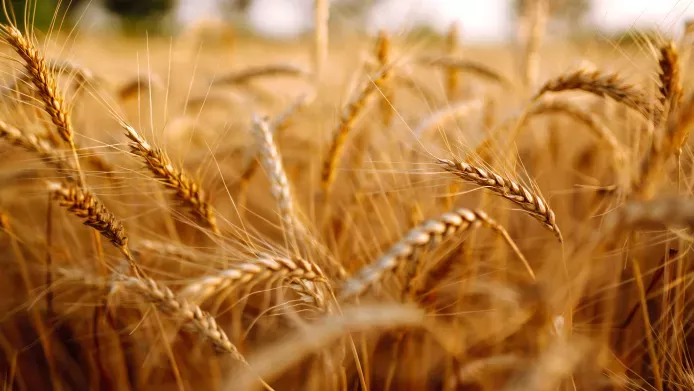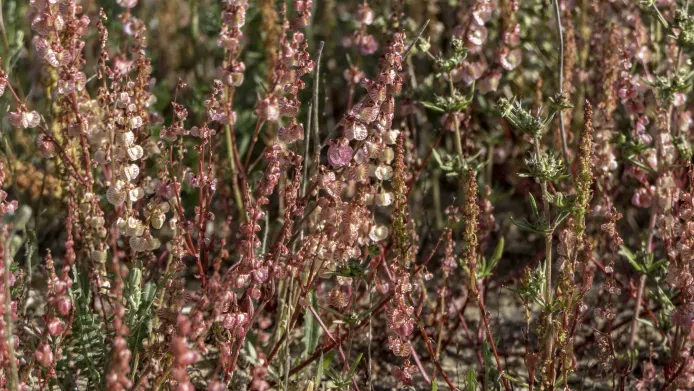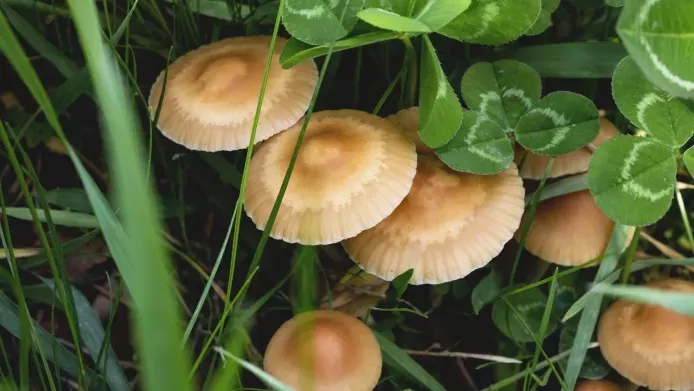Thousands of years ago, humans advanced from picking and eating things that grew in the wild to ‘cultivating’ plants: growing them purposefully to feed their families. This meant that they were less reliant on wild plants to provide for their needs.
This development of cultivation represents one of the greatest shifts in the way that humans today view nature. We view it as both contained, ordered and managed for human benefit, and as uncontained and 'wild'. Weeds bridge these two perceptions of nature, disrupting the order we attempt to bring.
But it wasn’t always that way…

Lungwort, Pulmonaria officinalis
A weed by any other name
One of the earliest examples of cultivation – from 23,000 years ago – included over 140 plant species, many of which were species that we currently think of as 'weeds'. [1]
We don’t even have to go back that far to find examples of people cultivating and eating weeds. In the year 1525, a landowner called Thomas Fromond published The Fromond List, a list of 'herbys [herbs] necessary for a garden'.
The list has nine different headings, which cover the different uses in food for such plants during the 16th century. These included plants for potage (soup), and for sauce. Within this list are several 'weeds', although they’re not treated any differently from the other plants, which suggests they would have been cultivated in the same gardens. [2]
Look through the list and you might recognise Tansey (tansy or Tanacetum vulgare), Chykynwede (chickweed or Stellaria media) and Cowsloppus of Jerusalem (lungwort or Pulmonaria officinalis) among others.

Tansy, Tanacetum vulgare
Weeds for a changing climate
Jump forward to today and the people who cultivate plants, especially commercially, are very aware of weeds! While there is a growing interest for cooking with weeds among foraging communities, there is little appetite for large scale cultivation.
However, this could change.
The onset of climate change has created problems for farmers: shifting weather patterns, hotter days and wetter seasons are all affecting how traditional crops grow. Some scientists think weed species could provide the answer.
A characteristic of a weed that makes them less popular, particularly among gardeners, is their resilience. This means that they can survive – and even thrive – in conditions where other plants may not.
With 80 per cent of our calorie intake coming from just 12 plant species, and 50 per cent of our calories coming from just the three big grasses – wheat, maize and rice – what would happen were we to lose one of these crops?

Wheat, Triticum
The Crop Wild Relatives Project
The Royal Botanic Gardens, Kew and its Millennium Seed Bank are part of a project that is helping to adapt agriculture to our changing climate, by collecting, protecting and preparing 'crop wild relatives'.
Crop wild relatives are wild plant species, many considered 'weeds', that are genetically related to cultivated crops. Untended by humans, they continue to evolve in the wild, developing traits such as drought tolerance or pest resistance that farmers and breeders can cross with domesticated crops to produce new varieties. [3]
Dr Chris Cockel, the Crop Wild Relatives Project Co-ordinator at Kew, says:
'Many crop wild relatives are successful exactly because of their weediness. They can survive without human intervention, which is what makes them so important, and is also why they’ve been overlooked until now. In many instances, they are just the plants that farmers don’t want growing in their fields, and are removed, which can also put them at risk.'
Harnessing the characteristics of weeds
Lewis Ziska, Research Plant Physiologist at the United States Department of Agriculture (USDA), is working to understand and harness the characteristics of weeds to see how they might be used to improve the outlook for cultivation in a changing climate. [4]
Red rice, which is also known as ‘weedy rice’ (Oryza sativa f. spontanea), is a wild relative of rice, which mimics the properties of cultivated rice. It is edible, but very difficult to harvest because once it develops seeds, they fall to ground and shatter.
When red rice is exposed to higher temperatures and high levels of CO2 – simulating the likely conditions that climate change will create – it grows taller and thicker, producing up to 90 per cent more seed than cultivated rice.
If Ziska and his team can transfer these attributes from red rice to cultivated rice, we will be a step closer to ensuring food security for the future.
Susan McCouch is a plant geneticist from Cornell who believes there are other wild ancestors with traits that could be harnessed in this way:
'There are still vast reserves of valuable genes and traits hidden in low-performing wild ancestors and long forgotten early farmer varieties that can be coaxed out of these ancient plants by crossing them with higher-yielding modern relatives. These crosses give rise to families of offspring that carry a myriad of new possibilities for the future.'

Sheep's sorrel, Rumex acetosella
We don’t need high tech labs to tell us that weeds have beneficial properties. For centuries different cultures have used dandelions (Taraxacum officinale) in food and in medicine, recognising its nutritional value and appreciating its flavour. It also contains inulin, which helps a special kind of bacteria to grow that has been associated with improving bowel function and general health. Now you can buy dandelion root tea in supermarkets and health food shops. [5]
Sheep’s sorrel (Rumex acetosella) is considered a troublesome weed by many gardeners and farmers but it is also a tasty leaf with hints of citrus and spinach that can be added to salad or made into pesto [6]. It grows abundantly if you give it half a chance, due to its shallow, spreading root system which regrows easily [7]. Perhaps in the future we will be buying UK-grown bags of sheep’s sorrel at the supermarket, rather than leafy greens grown overseas.
There is a cycle to life and weeds are no exception. What was once cultivated by our ancestors became a nuisance to gardeners, but these weedy crops could again become part of our staple diets.
More from the blog


References
[1] The Origin of Cultivation and Proto-Weeds, Long Before Neolithic Farming; https://journals.plos.org/plosone/article?id=10.1371/journal.pone.0131422
[2] The Fromond List [Herbys Necessary For A Gardyn]; http://cryptoforest.blogspot.com/2014/04/the-fromond-list-herbys-necessa...
[3] https://www.bioversityinternational.org/cwr/
[4] Agricultural Research Aims to Improve Harvests on Warmer Planet; https://www.voanews.com/a/agricultural-research-aims-to-improve-harvests-on-warmer-planet-122336524/173686.html
[5] Are Weeds the Future of Food?; https://www.ecowatch.com/are-weeds-the-future-of-food-1881919337.html
[6] 10 Reasons Weeds Are the Future of Food; https://medium.com/invironment/10-reasons-weeds-are-the-future-of-food-2...
[7] Sheep’s sorrel profile on RHS website; https://www.rhs.org.uk/advice/profile?pid=994
